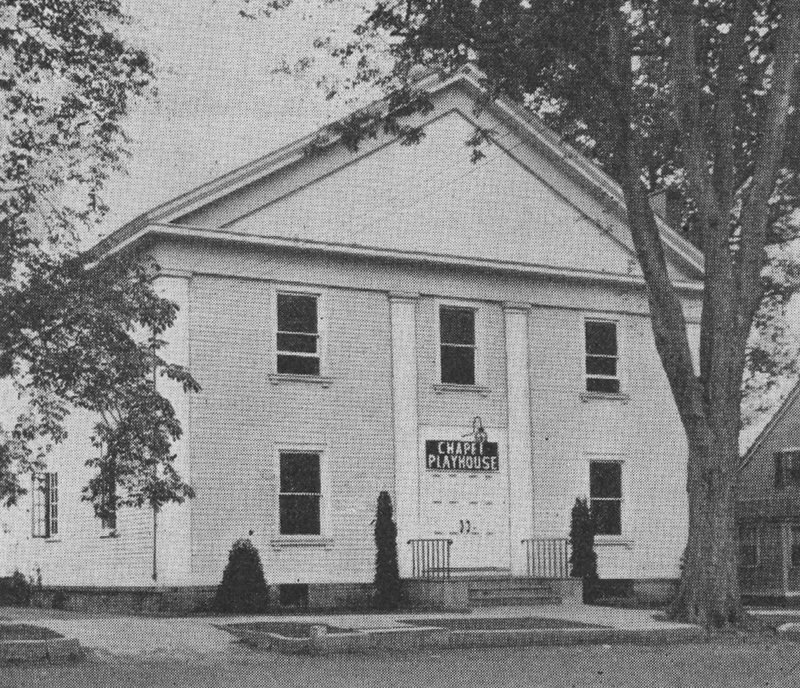Chapel Playhouse, 49 Park Street
Dublin Core
Title
Chapel Playhouse, 49 Park Street
Description
The Chapel Playhouse is pictured, circa 1940s.
Built in 1844 on land bought from Samuel Landon. Outspoken Abolitionists, 123 friends of Rev. Aaron Dutton, split from the First Congregational Church in 1832 because they were refused permission to hold meetings of the local Anti-Slavery Society. First called the Abolition Church, it was formally established as the Third Congregational Church with Rev. David Root installed as the first pastor. Structural changes to the building included lowering the foundation in 1862 to add height to the main room and the seats, previously facing the entrance at the western end of the building, turned toward the new pulpit at the eastern end. A gallery was added at the same time. A chapel at the rear was added in 1879. The church was dissolved in 1919, and the building was sold to Christ Church, who used the chapel as a parish house. The rest of the building was used as a theater for showing serious films. The steeple was removed sometime during the 1920s when it began to lean. In 1933 it was resold to state Sen. Harry R. Durant and named Chapel Playhouse. The building was converted for use as a summer stock theater, the New York-Guilford Players, run by producer J. Burleigh and with plays produced by Lou Tellegen, and for the Guilford Town Players. The Christian Science Society bought and restored it in 1951 and in 1955 the society changed its title to First Church of Christ, Scientist.
To the left is the Major Lathrop House, 55 Park Street; to the right is 43 Park Street.
Built in 1844 on land bought from Samuel Landon. Outspoken Abolitionists, 123 friends of Rev. Aaron Dutton, split from the First Congregational Church in 1832 because they were refused permission to hold meetings of the local Anti-Slavery Society. First called the Abolition Church, it was formally established as the Third Congregational Church with Rev. David Root installed as the first pastor. Structural changes to the building included lowering the foundation in 1862 to add height to the main room and the seats, previously facing the entrance at the western end of the building, turned toward the new pulpit at the eastern end. A gallery was added at the same time. A chapel at the rear was added in 1879. The church was dissolved in 1919, and the building was sold to Christ Church, who used the chapel as a parish house. The rest of the building was used as a theater for showing serious films. The steeple was removed sometime during the 1920s when it began to lean. In 1933 it was resold to state Sen. Harry R. Durant and named Chapel Playhouse. The building was converted for use as a summer stock theater, the New York-Guilford Players, run by producer J. Burleigh and with plays produced by Lou Tellegen, and for the Guilford Town Players. The Christian Science Society bought and restored it in 1951 and in 1955 the society changed its title to First Church of Christ, Scientist.
To the left is the Major Lathrop House, 55 Park Street; to the right is 43 Park Street.
Subject
Abolitionists; Church buildings -- Connecticut – Guilford; Guilford (Conn.). Chapel Playhouse; Church buildings -- Connecticut -- Guilford – History; Congregational churches -- Connecticut – Guilford; Guilford (Conn.) -- History
Source
Edith B. Nettleton Historical Room Collection
Publisher
Guilford Free Library
Rights
Digital image © Guilford Free Library. All rights reserved. Image may be used for personal research or educational uses without prior permission. For requests or exhibits, see Guilford Free Library.
Format
.JPG
Citation
“Chapel Playhouse, 49 Park Street,” Guilford Free Library Archives, accessed June 29, 2025, https://guilfordfreelibrary.org/gflarchives/items/show/39.

